High Sensitivity Refractometer Based on Reflective Smf-Small Diameter No Core Fiber Structure
Abstract
:1. Introduction
2. Theory and Simulation
3. Experimental Investigation
4. Conclusions
Acknowledgments
Author Contributions
Conflicts of Interest
References
- Wu, Q.; Semenova, Y.; Wang, P.F.; Farrell, G. High sensitivity SMS fiber structure based refractometer-analysis and experiment. Opt. Express 2011, 19, 7937–7944. [Google Scholar] [CrossRef]
- Liu, D.; Mallik, K.; Yuan, J.; Yu, C.; Farrell, G.; Semenova, Y.; Wu, Q. High sensitivity refractive index sensor based on a tapered small core single-mode fiber structure. Opt. Lett. 2015, 40, 4166–4169. [Google Scholar] [CrossRef]
- Liang, W.; Huang, Y.; Xu, Y.; Lee, R.K.; Yariv, A. Highly sensitive fiber Bragg grating refractive index sensors. Appl. Phys. Lett. 2005, 86, 151122. [Google Scholar] [CrossRef]
- Barrias, A.; Casas, J.R.; Villalba, S. A review of distributed optical fiber sensors for civil engineering applications. Sensors 2016, 16, 748. [Google Scholar] [CrossRef]
- Ramakrishnan, M.; Rajan, G.; Semenova, Y.; Farrell, G. Overview of fiber optic sensor technologies for strain/temperature sensing applications in composite materials. Sensors 2016, 16, 99. [Google Scholar] [CrossRef]
- Hromadka, J.; Korposh, S.; Partridge, M.C.; James, S.W.; Davis, F.; Crump, D.; Tatam, R.P. Multi-parameter measurements using optical fibre long period gratings for indoor air quality monitoring. Sens. Actuators B Chem. 2017, 244, 217–225. [Google Scholar] [CrossRef]
- Karabacak, D.M.; Farnan, M.; Ibrahim, S.K.; Todd, M.; Singer, J.M. Fiber optic sensors for multiparameter monitoring of large scale assets. In Proceedings of the 8th European Workshop on Structural Health Monitoring, Bilbao, Spain, 5–8 July 2016. [Google Scholar]
- Reyes, M.; David, M.H.; Alejandro, M.R.; Enrique, S.; Antonio, D.; José, L.C.; Miguel, V.A. A refractive index sensor based on the resonant coupling to cladding modes in a fiber loop. Sensors 2013, 13, 11260–11270. [Google Scholar] [CrossRef]
- Cai, L.; Zhao, Y.; Li, X. A fiber ring cavity laser sensor for refractive index and temperature measurement with core-offset modal interferometer as tunable filter. Sens. Actuators B Chem. 2017, 242, 673–678. [Google Scholar] [CrossRef]
- Usha, S.P.; Shrivastav, A.M.; Gupta, B.D. A contemporary approach for design and characterization of fiber-optic-cortisol sensor tailoring LMR and ZnO/PPY molecularly imprinted film. Biosens. Bioelectron. 2017, 87, 178–186. [Google Scholar] [CrossRef]
- Zhang, X.; Peng, W.; Liu, Y.; Pan, L. Core-cladding mode recoupling based fiber optic refractive index sensor. Opt. Commun. 2013, 294, 188–191. [Google Scholar] [CrossRef]
- Tripathia, S.M.; Bock, W.J.; Mikulic, P. A wide-range temperature immune refractive-index sensor using concatenated long-period-fiber-gratings. Sens. Actuators B Chem. 2017, 243, 1109–1114. [Google Scholar] [CrossRef]
- Wang, H.; Meng, H.; Xiong, R.; Wang, Q.; Huang, B.; Zhang, X.; Yu, W.; Tan, C.; Huang, X. Simultaneous measurement of refractive index and temperature based on asymmetric structures modal interference. Opt. Commun. 2016, 364, 191–194. [Google Scholar] [CrossRef]
- Rong, Q.; Qiao, X.; Guo, T.; Wang, R.; Zhang, J.; Hu, M.; Feng, Z.; Weng, Y.; Ma, Y. Temperature-calibrated fiber-optic refractometer based on a compact FBG-SMS structure. Chin. Opt. Lett. 2012, 10, 030604. [Google Scholar] [CrossRef]
- Xu, F.; Horak, P.; Brambilla, G. Optical microfiber coil resonator refractometric sensor. Opt. Express 2007, 15, 7888–7893. [Google Scholar] [CrossRef]
- Bilro, L.; Alberto, N.J.; Sá, L.M.; Lemos Pinto, J.; Nogueira, R. Analytical analysis of side-polished plastic optical fiber as curvature and refractive index sensor. J. Lightwave Technol. 2011, 29, 864–870. [Google Scholar] [CrossRef]
- Ding, M.; Wang, P.; Brambilla, G. A microfiber coupler tip thermometer. Opt. Express 2012, 20, 5402–5408. [Google Scholar] [CrossRef]
- Liao, C.; Wang, D.; He, X.; Yang, M. Twisted optical microfiber for refractive index sensing. IEEE Photonics Technol. Lett. 2011, 23, 848–850. [Google Scholar] [CrossRef]
- Faizul Huq Arif, M.; Jaminul Haque Biddut, M. A new structure of photonic crystal fiber with high sensitivity, high nonlinearity, high birefringence and low confinement loss for liquid analyte sensing applications. Sens. Bio-Sens. Res. 2017, 12, 8–14. [Google Scholar] [CrossRef]
- Rifat, A.A.; Amouzad Mahdiraji, G.; Shee, Y.G.; Jubayer Shawon, Md.; Mahamd Adikan, F.R. A novel photonic crystal fiber biosensor using surface plasmon resonance. Procedia Eng. 2016, 140, 1–7. [Google Scholar] [CrossRef]
- Liang, H.; Miranto, H.; Granqvist, N.; Sadowski, J.W.; Viitala, T.; Wang, B.; Yliperttula, M. Surface plasmon resonance instrument as a refractometer for liquids and ultrathin films. Sens. Actuators B Chem. 2010, 149, 212–220. [Google Scholar] [CrossRef]
- Gowri, A.; Sai, V.V.R. Development of LSPR based U-bent plastic optical fiber sensors. Sens. Actuators B Chem. 2016, 230, 536–543. [Google Scholar] [CrossRef]
- Velázquez-González, J.S.; Monzón-Hernández, D.; Martínez-Piñón, F.; Hernández-Romano, I. Highly sensitive surface plasmon resonance-based optical fiber multi-parameter sensor. Procedia Eng. 2016, 168, 1249–1252. [Google Scholar] [CrossRef]
- Wang, Y.; Yang, M.; Wang, D.; Liu, S.; Lu, P. Fiber in-line Mach-Zehder interferometer fabricated by femtosecond laser micromachining for refractive index measurement with high sensitivity. J. Opt. Soc. Am. B 2010, 27, 370–374. [Google Scholar] [CrossRef]
- Lu, P.; Men, L.; Sooley, K.; Chen, Q. Tapered fiber Mach-Zehnder interferometer for simultaneous measurement of refractive index and temperature. Appl. Phys. Lett. 2009, 94, 131110. [Google Scholar] [CrossRef]
- Pevec, S.; Donlagic, D. Nanowire-based refractive index sensor on the tip of an optical fiber. Appl. Phys. Lett. 2013, 102, 213114. [Google Scholar] [CrossRef]
- Zhu, S.; Pang, F.; Huang, S.; Zou, F.; Guo, Q.; Wen, J.; Wang, T. High sensitivity refractometer based on TiO2-Coated adiabatic tapered optical fiber via ALD technology. Sensors 2016, 16, 1295. [Google Scholar] [CrossRef]
- Raghunandhana, R.; Chen, L.H.; Long, H.Y.; Leam, L.L.; So, P.L.; Ning, X.; Chan, C.C. Chitosan/PAA based fiber-optic interferometric sensor for heavy metal ions detection. Sens. Actuators B Chem. 2016, 233, 31–38. [Google Scholar] [CrossRef]
- Chen, L.H.; Chan, C.C.; Menon, R.; Balamurali, P.; Wong, W.C.; Ang, X.M.; Hu, P.B.; Shaillender, M.; Neu, B.; Zu, P.; et al. Fabry-Perot fiber-optic immunosensor based on suspended layer-by-layer (chitosan/polystyrene sulfonate) membrane. Sens. Actuators B Chem. 2013, 188, 185–192. [Google Scholar] [CrossRef]
- Wu, Q.; Semenova, Y.; Wang, P.F.; Farrell, G. A comprehensive analysis verified by experiment of a refractometer based on an SMF28-Small-Core Singlemode fiber (SCSMF)-SMF28 fiber structure. J. Opt. 2011, 13, 125401. [Google Scholar] [CrossRef]
- Zhao, Y.; Cai, L.; Li, X.; Meng, F.; Zhao, Z. Investigation of the high sensitivity RI sensor based on SMS fiber structure. Sens. Actuators A Phys. 2014, 205, 186–190. [Google Scholar] [CrossRef]
- Gao, R.; Wang, Q.; Zhao, F.; Meng, B.; Qu, S. Optimal design and fabrication of SMS fiber temperature sensor for liquid. Opt. Commun. 2010, 283, 3149–3152. [Google Scholar] [CrossRef]
- Xia, T.; Zhang, A.; Gu, B.; Zhu, J. Fiber-optic refractive-index sensors based on transmissive and reflective thin-core fier modal interferometers. Opt. Commun. 2010, 283, 2136–2139. [Google Scholar] [CrossRef]
- Huang, L.S.; Lin, G.R.; Fu, M.Y.; Sheng, H.J.; Sun, H.T.; Liu, W.F. A refractive-index fiber sensor by using no-core fibers. In Proceedings of the 2013 IEEE International Symposium on Next-generation Electronics, Kaohsiung, Taiwan, 25–26 February 2013. [Google Scholar]
- Zhao, J.; Wang, J.; Zhang, C.; Guo, C.; Bai, H.; Xu, W.; Chen, L.; Miao, C. Refractive index fiber laser sensor by using tunable filter based on no-core fiber. IEEE Photonics J. 2016, 8, 6805008. [Google Scholar] [CrossRef]
- Li, Y.; Liu, Z.; Jian, S. Multimode interference refractive index sensor based on coreless fiber. Photonic Sens. 2014, 4, 21–27. [Google Scholar] [CrossRef]
- Bueno, A.; Caucheteur, C.; Kinet, D.; Mégret, P. Refractive index sensors based on optical fiber hetero-core structure and Fabry-Pérot interferometers. Proc. SPIE 2013, 8794. [Google Scholar] [CrossRef]
- Soldano, L.B.; Pennings, E.C.M. Optical multi-mode interference devices based on self-imaging principles and applications. J. Lightwave Technol. 1995, 13, 615–627. [Google Scholar] [CrossRef]
- Wang, Q.; Farrell, G.; Yan, W. Investigation on single-mode-multimode-single-mode fiber structure. J. Lightwave Technol. 2008, 26, 512–519. [Google Scholar] [CrossRef]
- Mohammed, W.S.; Mehta, A.; Johnson, E.G. Wavelength tunable fiber lens based on multimode interference. J. Lightwave Technol. 2004, 22, 469–477. [Google Scholar] [CrossRef]
- Yu, C.; Wu, Y.; Liu, X.; Fu, F.; Gong, Y.; Rao, Y.; Chen, Y. Miniature fiber-optic NH3 gas sensor based on Pt nanoparticle-incorporated graphene oxide. Sens. Actuators B Chem. 2017, 244, 107–113. [Google Scholar] [CrossRef]
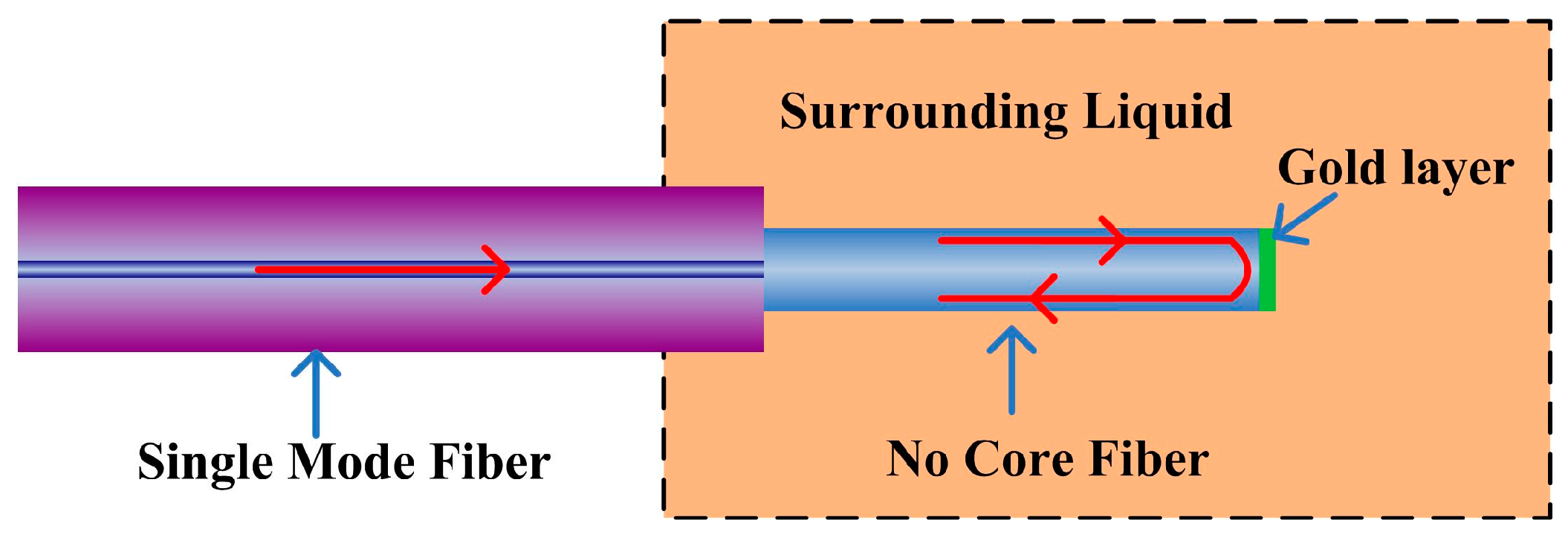

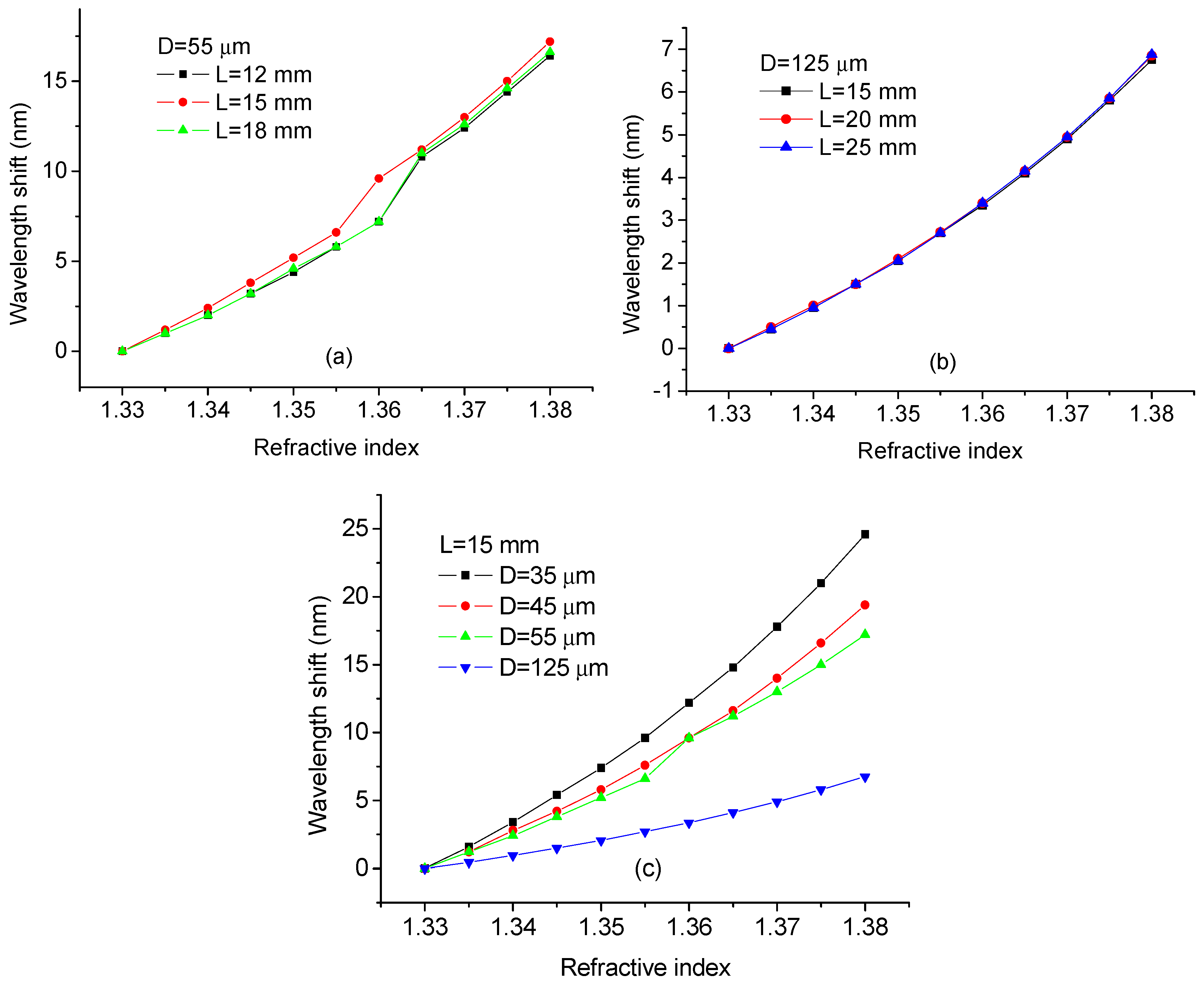
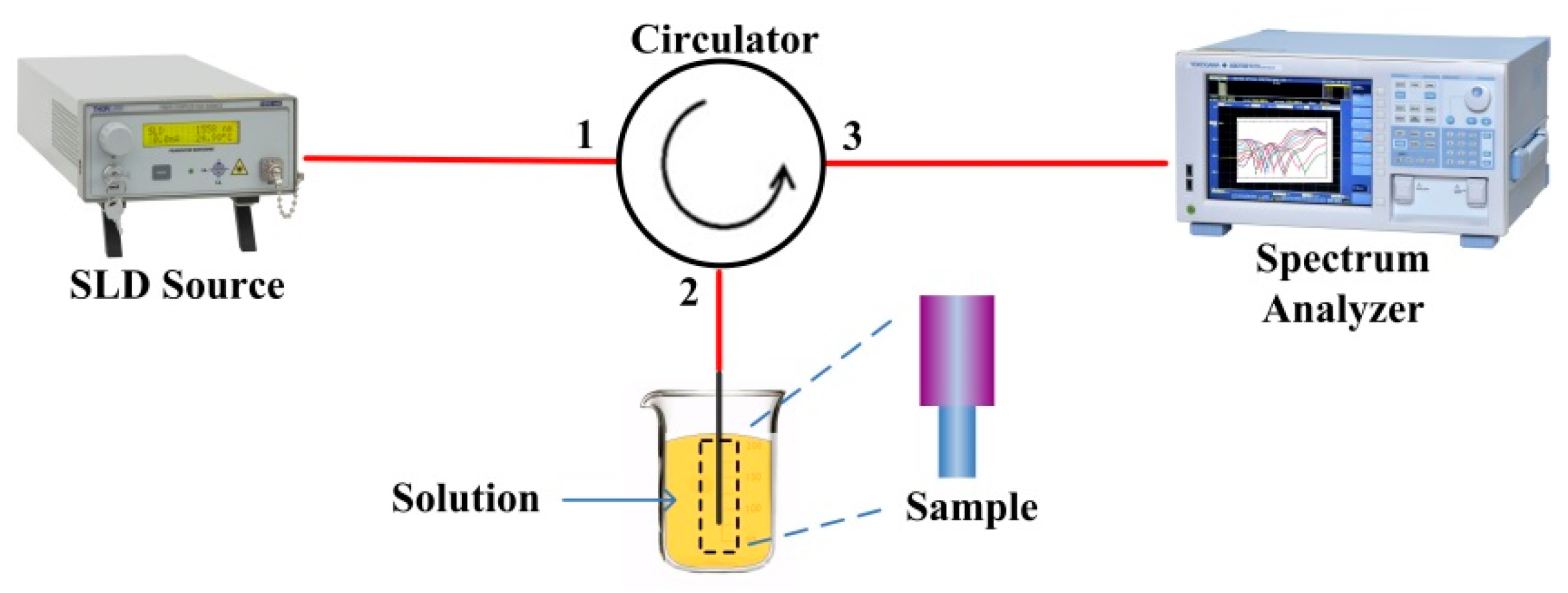
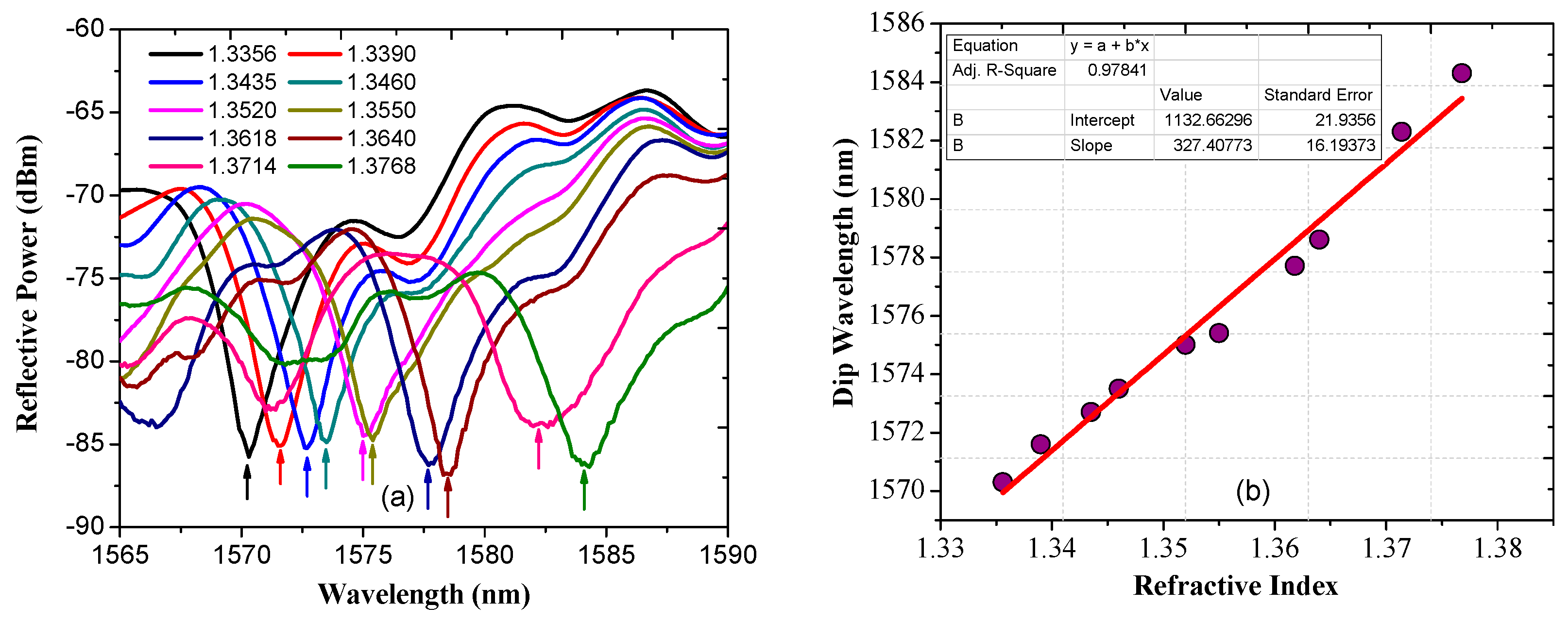
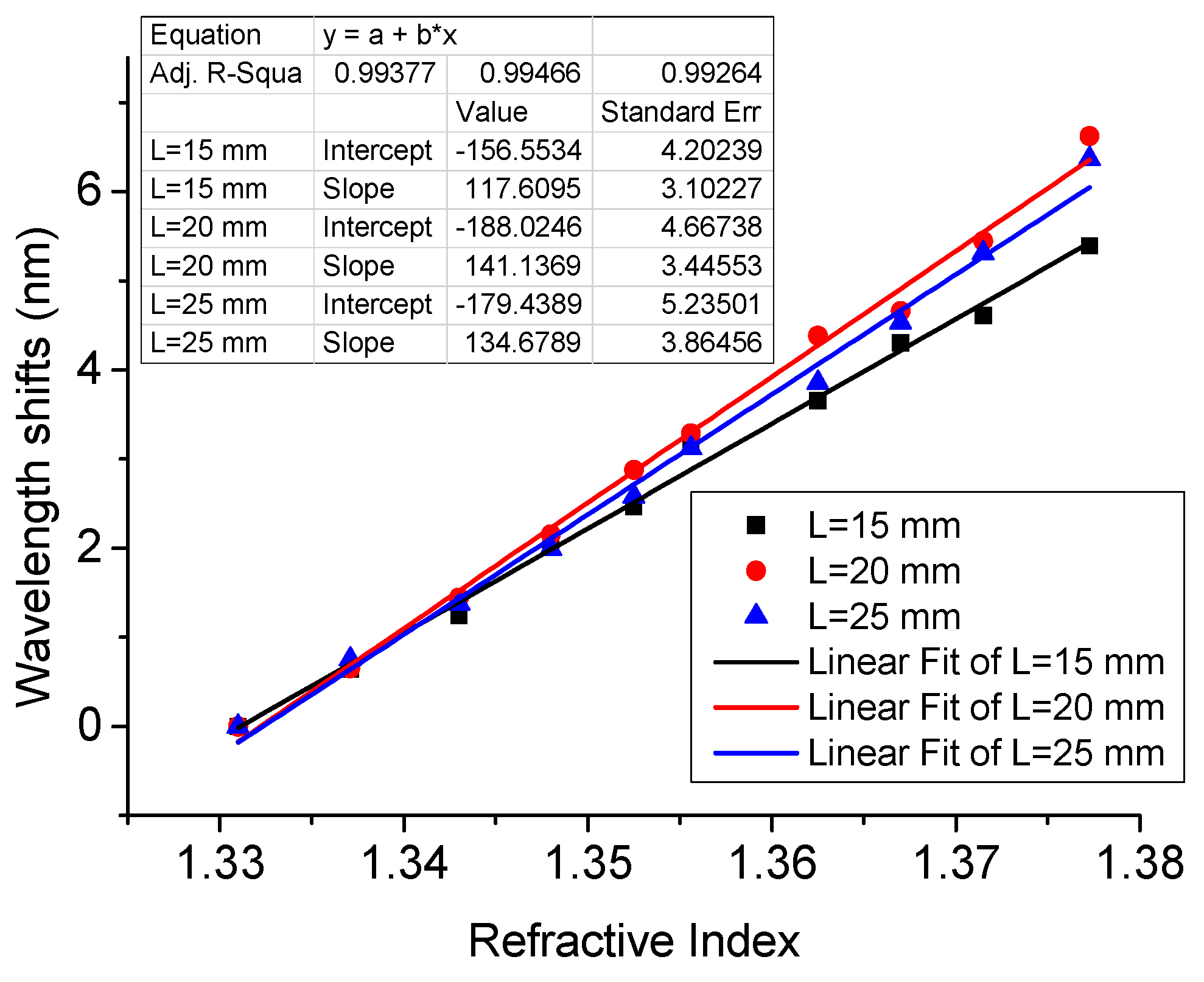
| No. | Type of Sensor | Sensitivity (nm/RIU) | Ref. |
|---|---|---|---|
| 1 | Tapered single-mode optical fiber | 26.087 | [25] |
| 2 | The thin-core fiber modal interferometers | 135.5 | [33] |
| 3 | The no-core fibers | 227.14 | [34] |
| 4 | Etched multimode fiber | 286.2 | [31] |
| 5 | The small diameter no-core fiber (SDNCF) | 327 | This work |
© 2017 by the authors. Licensee MDPI, Basel, Switzerland. This article is an open access article distributed under the terms and conditions of the Creative Commons Attribution (CC BY) license (http://creativecommons.org/licenses/by/4.0/).
Share and Cite
Zhou, G.; Wu, Q.; Kumar, R.; Ng, W.P.; Liu, H.; Niu, L.; Lalam, N.; Yuan, X.; Semenova, Y.; Farrell, G.; et al. High Sensitivity Refractometer Based on Reflective Smf-Small Diameter No Core Fiber Structure. Sensors 2017, 17, 1415. https://doi.org/10.3390/s17061415
Zhou G, Wu Q, Kumar R, Ng WP, Liu H, Niu L, Lalam N, Yuan X, Semenova Y, Farrell G, et al. High Sensitivity Refractometer Based on Reflective Smf-Small Diameter No Core Fiber Structure. Sensors. 2017; 17(6):1415. https://doi.org/10.3390/s17061415
Chicago/Turabian StyleZhou, Guorui, Qiang Wu, Rahul Kumar, Wai Pang Ng, Hao Liu, Longfei Niu, Nageswara Lalam, Xiaodong Yuan, Yuliya Semenova, Gerald Farrell, and et al. 2017. "High Sensitivity Refractometer Based on Reflective Smf-Small Diameter No Core Fiber Structure" Sensors 17, no. 6: 1415. https://doi.org/10.3390/s17061415
APA StyleZhou, G., Wu, Q., Kumar, R., Ng, W. P., Liu, H., Niu, L., Lalam, N., Yuan, X., Semenova, Y., Farrell, G., Yuan, J., Yu, C., Zeng, J., Tian, G. Y., & Fu, Y. Q. (2017). High Sensitivity Refractometer Based on Reflective Smf-Small Diameter No Core Fiber Structure. Sensors, 17(6), 1415. https://doi.org/10.3390/s17061415








